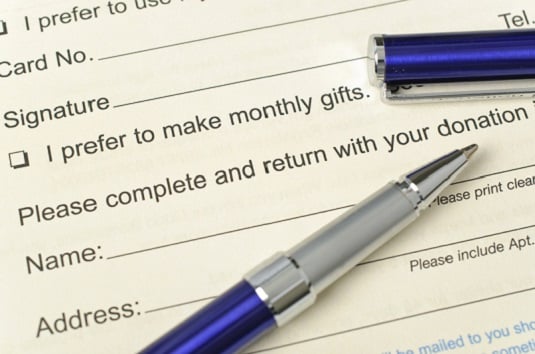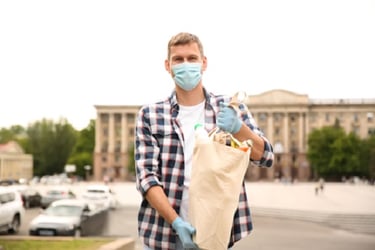
7 outreach ideas for nurturing donors when in-person events aren’t an option.
Since COVID-19 hit, the highs and lows of major donor relationships have felt more real than ever before.
Take Love Conquers Violence’s big annual event, for example. For the last four years, the annual cornhole tournament has been a highlight for major donors, volunteers, and beneficiaries. Last year, they raised $31,000 to end domestic violence through awareness and scholarships given in honor of Natalie Beissel, the founder’s sister, who was a victim of domestic violence.
But this year, they were disappointed to realize that one of their largest events would have to go virtual — potentially risking their relationships with major donors and their community alike.
Thankfully, they were quickly able to pivot. Instead of their cornhole tournament, they’ll now offer a 30-minute show telling the stories of people positively affected by Love Conquers All through submitted videos.
It’s a rollercoaster I am sure you’re familiar with. Pretty much every nonprofit has had to make the shift to virtual events and use other creative approaches to fulfill their missions, help their communities, engage with donors, and raise funds.
But we’ve come up with 7 outreach ideas to get the creative juices flowing, so you can reach and nurture major donors. Let’s get started.
- The Good, the Bad, and the Real
- A Few Other Key Questions
- Keep It Personal
- 7 Outreach Ideas That Go Beyond In-Person Events
- Make a personal phone call.
- Send a personal email.
- Send a handwritten note.
- Send a video message from a beneficiary.
- Send a book or magazine they might find interesting.
- Send a custom impact report.
- Invite them to a virtual or hybrid event.
The Good, the Bad, and the Real
It’s important to understand, if we can, the true state of giving in the midst of COVID-19. A recent QuickBooks survey conducted March 25 reveals that, of 2,000 people who give to nonprofits regularly, 47 percent “are giving less than they were a month ago,” and 34 percent had given less than they did by the same point last year. That’s nearly half of respondents who have cut back on giving since COVID-19.
But there’s another side to the story that’s more hopeful. In a special edition of the Better Business Bureau’s Give.org Donor Trust Report survey that was commissioned to gauge donor response to COVID-19, we find that “close to one-third of Americans plan to give more to charities in 2020”.
What’s more, even if formal giving to charities is struggling, a LendingTree survey reports that people are giving in other ways.
- 37 percent said they were tipping more than usual
- 12 percent had sent money to a loved one who had been laid off
- 7 percent had purchased a gift card from a local business
These new reports and surveys prove that people are still willing to give, but they’ve had to adapt just as nonprofits have had to react to new needs and goals.
The reality is that, though COVID-19 has created major challenges in reaching major donation goals, it’s not impossible to achieve our objectives.
And if you break down one of the most significant questions we must ask ourselves to overcome these pandemic challenges, it’s what do we do when major donor relationships thrive on in-person interaction, but we now must nurture them while practicing social distancing?
A Few Other Key Questions
Before you can start brainstorming about innovative ways to nurture major donors and raise the necessary funds for your nonprofit, you have to try and get a pulse on how your donors are doing. Even if your donors haven’t been laid-off or furloughed, we should expect everyone’s focus to shift a little inward as fears and uncertainties about health and job security come to the forefront.
But that doesn’t mean that your nonprofit doesn’t matter to your donors. Don’t be afraid to ask them what they need and expect from your organization right now. And another big question to ask them is how much interaction is too much or too little at this time?
Many nonprofits are developing quick surveys and sending them via email, including them at the end of virtual events, and even posting them on social media to not only better understand their donor’s attitudes, but letting them know the organization still cares and wants to be respectful of how COVID-19 has affected them.
Keep it Personal
Nonprofits are usually good at keeping things personal. After all, many nonprofits start with personal causes, and they attract donors and volunteers who are highly motivated by their own personal connections to an organization.
Well, it turns out, COVID-19 has made personalization a need-to-have, rather than a nice-to-have. CauseMatch has analyzed the data from its current live campaigns and found the average gift size is twice as large for city-specific organizations. National organizations aren’t eliciting the same size donations as local, city-based nonprofits.
Why are local organizations and campaigns succeeding when national campaigns are lagging behind? Many point to the investment in personal relationships that are unique to local nonprofits.
With local organizations, it’s often easier and less expensive to reach out and nurture individuals that are nearby, and local donors are more likely to attend events and forge connections that can be a challenge for national donors. This builds trust and commitment — two things that persevere and influence people to give even during times of crisis.
To build trust on local and national levels, the ability to customize communications, campaigns, even parts of your website is key. And there are lots of tools and CRMs that allow you to keep track of a donor’s history, preferences, and interests that make personalized notes, emails, ads, and landing pages a possibility.
Here are a couple of examples of donor emails that personalized their messages based on specific attributes of their donors, and if you’re wondering how to start getting personal using a CRM, check out this guide to send customized messages that resonate with the right people at the right times.
7 Outreach Ideas That Go Beyond In-Person Events
Make a personal phone call.
You can’t go wrong with a good, old-fashioned phone call. And since people are staying at homes and craving human interaction, the likelihood of a donor answering and being willing to speak with you are high.
To make a personal phone call count, start the conversation by asking the questions we laid out at the beginning of this blog. Ask them how your organization can help them and if their involvement has changed. And even though it’s a phone call, it’s still good to plan to end with a clear call-to-action whether it’s inviting them to a virtual event, asking them to complete a survey, or asking if you can send them more information.
Send a personal email.
You just saw some examples of fun ways to make emails personal, so we encourage you to play around with the data in your CRM and look for unique ways to customize communications. In addition to messages specific to donors’ locations and demographics, you could look for opportunities to personalize emails based on interests.
Have a group of donors who enjoy music? Create a Spotify playlist with uplifting songs and email it to them.
Or if they like to cook, include a recipe that has a tie to your organization, maybe a local favorite or a beneficiary’s favorite dish.
Send a handwritten note.
Just like phone calls, the handwritten note is making a comeback. It’s just a nice way to connect with someone and gives people an excuse to go outside on a walk to the mailbox (we don’t know about you, but that’s definitely one of our top sources of joy these days).
The handwritten note can be a personal invite to an event or call-to-action, but it could also be a letter from a volunteer or beneficiary that provides a quick organizational update.
Send a video message from a beneficiary.
Speaking of messages from beneficiaries, a video is another example of telling a good story and building a personal connection if handwritten letters aren’t your thing. And the good thing about video messages is that they can be saved and shared across different mediums. But you can also still personalize videos with a customized greeting.
A quick clip expressing thanks and an update on the beneficiary’s life is the type of positivity everyone needs right now, and it serves as a good reminder to donors that they’re donations have made a difference and that there’s still a need.
Send a book or magazine they might find interesting.
Whether you’re social distancing inside or by a private pool, it’s a great time to catch up on some reading. Depending on the book or magazine, you could send it via mail or a digital copy by way of email, but either way, the gift of a good book goes a long way for many people.
You can choose a book or publication that you feel represents your organization well, or this is another opportunity where you can filter data through a CRM. If you can see donors have a niche interest like travel or languages, you can send a book or magazine related to one of their favorite topics.
Send a custom impact report.
Impact reports are a huge part of what nonprofits do as a way of educating members and donors on the issues that influence your organization and a way to be transparent about how your nonprofit’s resources and donations are changing lives.
Some impact reports are formal breakdowns of the numbers and others look more like an infographic that highlights the most compelling stories and data. It just depends on who your donors are. Either way, you can send the impact report via a personalized email, and you can include a small section of the report that breaks down the impact by donation amount, region, events, etc., so your donors can see how their donation has made a difference in a way that’s a little more personal.
Invite them to a virtual or hybrid event.
You knew the idea for a virtual event was coming. At this point, many of us have attended some sort of virtual event whether it’s a large, family meet-up over Zoom, a virtual trivia game, or even a digital game of Pictionary with your work colleagues. All of these are great ideas for a virtual fundraiser. If you have a great idea for a virtual event but don’t quite know where to begin, there are excellent resources to help you get started.
Depending on your state’s rules for COVID-19 protection, you could also consider a hybrid event. For example, the Greater Longview United Way turned their annual Pacesetter Kickstarter — usually a sit-down breakfast — into an event where partners and companies drove through the parking lot and picked up a to-go breakfast and informational packets.
COVID-19 has forced all of us to get creative and adapt to change in ways we could never have foreseen, but the good news is that donors understand: they’re in the same situation as you. We predict that if you try the tactics we discussed, you’ll be able to continue building connections and raising money despite social distancing. Let us know if you have any other suggestions!
 AUTHOR BIO
AUTHOR BIO
Sayana Izmailova is the Content Marketing Specialist at Wild Apricot, a membership management software. She has worked at a number of nonprofits and uses her experience to help small organizations advance their missions.



